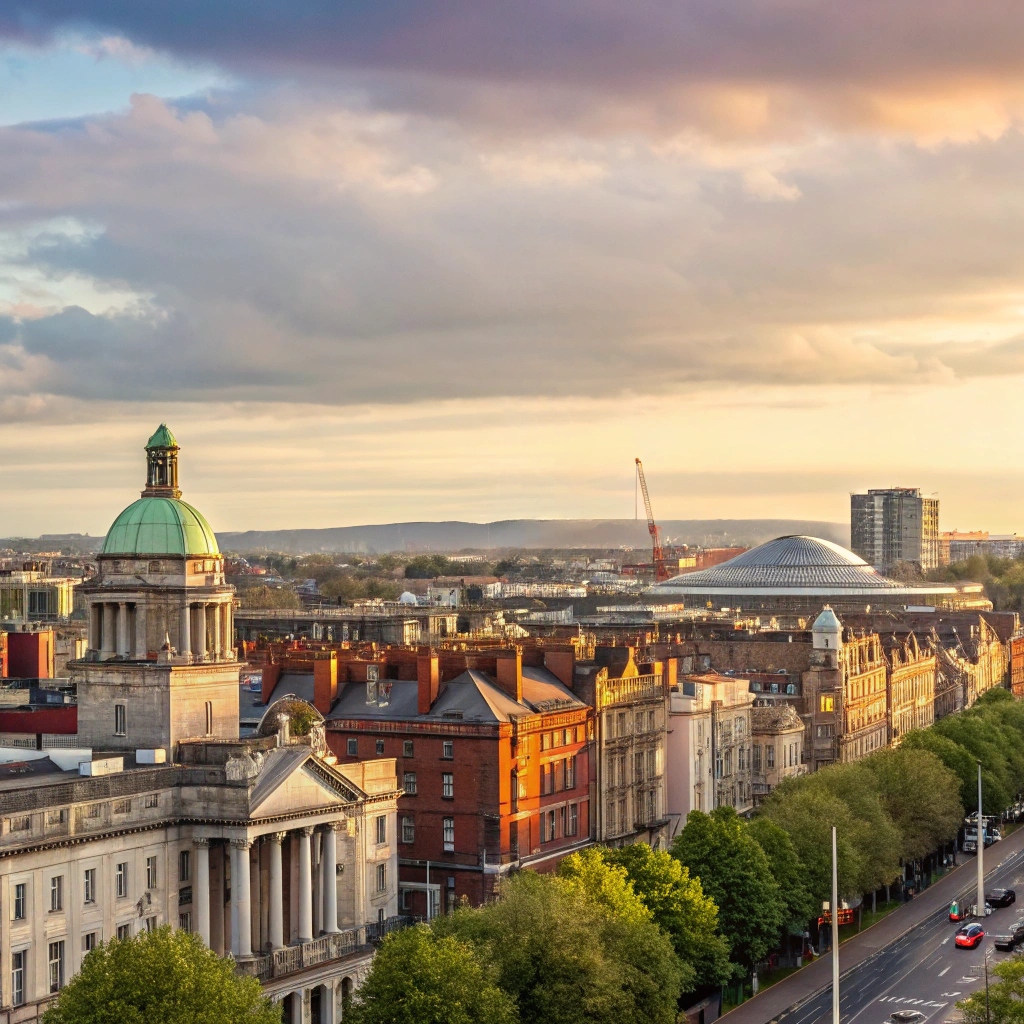Dublin—the vibrant capital of Ireland—is a city where centuries of history meet modern energy, creating an unforgettable experience for travelers. Whether you’re drawn to its literary heritage, historic landmarks, or bustling cultural scene, Dublin offers a perfect blend of attractions that can be thoroughly enjoyed in a three-day itinerary. This guide is designed to help you navigate Dublin like a local, highlighting must-see sites, practical tips, and insider recommendations.
Introduction
Dublin is more than just the capital city—it’s a gateway to Irish culture, history, and hospitality. In just three days, you can explore centuries-old castles, stroll through lush parks, and experience a vibrant modern art and music scene. This guide outlines a detailed itinerary, complete with historical insights, local dining suggestions, and practical travel tips. Get ready to experience Dublin’s charm from ancient streets to contemporary hotspots!
Day 1: Discovering Historic Dublin
Morning: A Walk Through History
Trinity College and the Book of Kells
Begin your day at Trinity College, Ireland’s oldest university. Its stunning Long Room in the Old Library houses the Book of Kells, a beautifully illuminated manuscript dating back over 1,200 years.
- Tip: Join a guided tour to gain insights into the history of the book and the college’s fascinating architecture.
Dublin Castle
A short walk from Trinity College, Dublin Castle is a historic complex that has played a key role in Ireland’s political history. Wander through the State Apartments, Chapel Royal, and the castle’s gardens while learning about its evolution from a medieval fortress to a modern government complex.
Afternoon: Cultural and Culinary Delights
St. Patrick’s Cathedral
After lunch, head to St. Patrick’s Cathedral, one of Dublin’s most iconic landmarks. Founded in 1191, this Gothic masterpiece is rich with history and offers a peaceful respite from the bustling city.
- Fun Fact: St. Patrick’s Cathedral is the National Cathedral of the Church of Ireland and has been associated with many significant events in Irish history.
Lunch Recommendation:
Enjoy a hearty Irish meal at a traditional pub near the cathedral. Look for local specialties like Irish stew or fish and chips.
The Chester Beatty Library
Next, explore the Chester Beatty Library, located within the Dublin Castle complex. This museum houses a remarkable collection of manuscripts, rare books, and artworks from Asia, the Middle East, and Europe.
- Tip: Allocate at least an hour to fully appreciate the diverse collections and unique exhibits.
Evening: Experiencing Dublin’s Nightlife
Temple Bar District
Wrap up your first day in the heart of Dublin’s cultural scene—the Temple Bar district. Known for its lively atmosphere, traditional Irish music, and eclectic mix of restaurants and bars, Temple Bar is perfect for an evening stroll or a relaxed dinner.
- Recommendation: Savor a pint of Guinness and soak up the local vibe in one of the many authentic pubs.
Day 2: Art, Literature, and Local Flavors
Morning: Literary Landmarks
The Dublin Writers Museum
Begin your day by diving into Dublin’s rich literary heritage at the Dublin Writers Museum. Learn about the lives and works of famous Irish writers such as James Joyce, W.B. Yeats, and Samuel Beckett.
- Insider Tip: Check the museum’s schedule for any temporary exhibits or special readings that might enhance your visit.
Ha’penny Bridge and Grafton Street
After exploring the museum, take a leisurely walk to the Ha’penny Bridge—a symbol of Dublin’s charm—and then head to Grafton Street for some shopping and street performances.
Afternoon: Museums and Markets
National Museum of Ireland – Archaeology
Spend your afternoon at the National Museum of Ireland – Archaeology. Discover exhibits featuring prehistoric artifacts, medieval treasures, and Viking relics that tell the story of Ireland’s past.
- Tip: Look out for the bog bodies and the gold artifacts that are among the museum’s highlights.
Lunch at a Local Café or Market
For lunch, visit one of Dublin’s bustling food markets or a charming café. Sample local treats like soda bread or freshly baked pastries, and enjoy a relaxed meal with locals.
- Tip: Ask your server for recommendations on local specialties—you might discover a hidden gem!
Evening: The Artistic Side of Dublin
Modern Art Gallery and Street Art Tours
Dublin is also home to a vibrant modern art scene. Visit the Irish Museum of Modern Art (IMMA) to see contemporary works by Irish and international artists. Alternatively, consider joining a street art tour to explore the creative murals that adorn Dublin’s urban landscape.
- Recommendation: Street art tours are a great way to see the city from a new perspective and meet local artists.
Dinner and Live Music in a Traditional Pub
Conclude your second day with dinner at a traditional Irish pub known for its live music. Enjoy dishes that blend contemporary cuisine with traditional Irish ingredients while listening to soulful tunes that capture Dublin’s spirit.
Day 3: Exploring Dublin’s Green Spaces and Local Neighborhoods
Morning: Nature and Serenity
Phoenix Park
Start your final day in Dublin with a visit to Phoenix Park—one of Europe’s largest urban parks. Home to Dublin Zoo, expansive green fields, and picturesque gardens, Phoenix Park offers a refreshing break from the city’s hustle and bustle.
- Activities: Rent a bicycle or simply take a leisurely walk to explore the park’s trails and landmarks, such as the Wellington Monument.
- Tip: Early morning visits are ideal for enjoying the tranquility and spotting local wildlife.
Afternoon: Neighborhood Exploration and Local History
Kilmainham Gaol
After enjoying nature, head to Kilmainham Gaol for a sobering yet essential look at Ireland’s revolutionary past. This former prison is now a museum that chronicles the struggle for Irish independence.
- Insight: Guided tours offer in-depth stories of the historical events and individuals who shaped modern Ireland.
Lunch in a Trendy Neighborhood
For lunch, explore one of Dublin’s trendy neighborhoods such as Smithfield or Stoneybatter. These areas are known for their boutique cafés, artisanal bakeries, and modern eateries that combine innovative flavors with local ingredients.
- Tip: Try a fusion dish that highlights traditional Irish produce with a modern twist.
Evening: A Relaxed Finale
Evening Stroll Along the Liffey and Dinner by the River
As your three-day adventure comes to a close, take an evening stroll along the River Liffey. Enjoy the illuminated bridges, the gentle flow of the water, and the lively atmosphere of Dublin’s quays.
- Dinner Recommendation: Dine at a riverside restaurant where you can savor contemporary Irish cuisine while watching the city light up at night.
Optional: Catch a Live Performance or Show
If time allows, consider capping off your visit with a live performance at one of Dublin’s renowned theaters or music venues. Whether it’s a play, a concert, or a traditional Irish dance show, this is a wonderful way to experience the creative energy that defines the city.
Practical Tips for Your Dublin Visit
Getting Around
- Public Transportation: Dublin’s extensive bus and tram (LUAS) networks make it easy to get around. Consider purchasing a Leap Card for convenience and savings.
- Walking: Many of Dublin’s attractions are clustered in the city center, so be prepared to explore on foot.
- Bicycles and Scooters: For a more active exploration, consider renting a bicycle or an electric scooter.
When to Visit
- Best Seasons: Dublin is delightful year-round, but spring (April to June) and early autumn (September to October) often offer mild weather and fewer crowds.
- Event Timing: Check local event calendars before your visit, as Dublin hosts numerous festivals, markets, and cultural events that can enhance your experience.
Where to Stay
Dublin offers a wide range of accommodations to suit every budget and preference. Consider staying in central areas such as Temple Bar, Trinity College, or St. Stephen’s Green for easy access to major attractions.
Insider Recommendations
- Local Tours: Guided walking tours and hop-on hop-off bus tours can provide valuable insights into Dublin’s history and culture.
- Cultural Apps: Download local apps or consult tourism websites to stay updated on events, pop-up markets, and exhibitions during your stay.
- Dining Reservations: Dublin’s popular restaurants and pubs can fill up quickly—booking a table in advance is often a smart move.
Conclusion
Three days in Dublin offer a balanced taste of history, culture, and modern vibrancy. From the hallowed halls of Trinity College to the lively beats in Temple Bar, and from the peaceful expanses of Phoenix Park to the poignant lessons at Kilmainham Gaol, Dublin invites you to explore its layers and immerse yourself in its story. With a well-planned itinerary, insider tips, and a spirit of adventure, you’ll leave Dublin with unforgettable memories and a deep appreciation for the city’s unique charm.
Pack your bags, prepare your walking shoes, and get ready to experience Dublin in all its multifaceted glory. Happy travels, and may your Dublin adventure be as rich and inspiring as the city itself!


